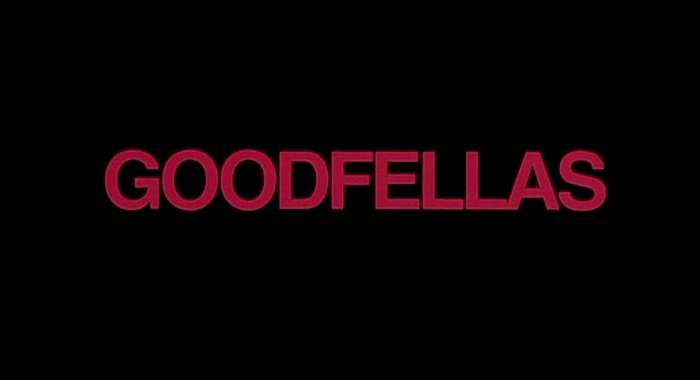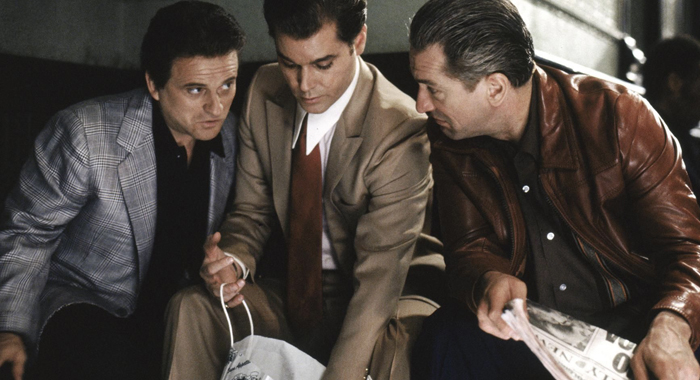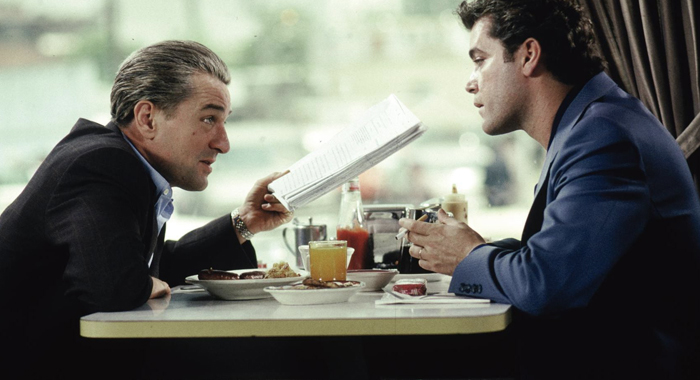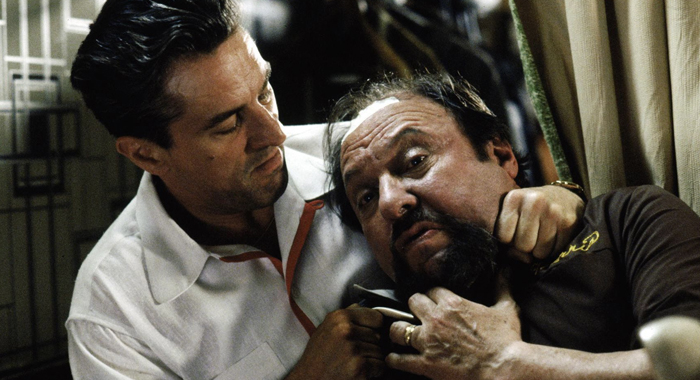
Martin Scorsese’s massively influential true-life 1990 mob-drama Goodfellas opens in 1970, with its lead mobsters Henry Hill (Ray Liotta), Tommy Devito (Joe Pesci) and James “Jimmy The Gent” Conway (Robert De Niro) in a car on a dark, lonely road. At the wheel of the car, Hill looks exhausted but determined when he hears a weird noise outside. Did he hit a deer? Does he have a flat tire?
Hill drives to the side of the road and he and his partners get out and discover that the urgent pounding they’ve been hearing has been coming from the trunk, where a fat, terrified man wrapped in a sheet is oozing blood and guts. Hill opens the trunk before an enraged Tommy gets a machete and finishes the job of ripping open the soon-to-be-corpse with a massive blade while profanely cursing the man out for having the audacity to cling desperately to life when they really need him to be dead. In an almost literal act of overkill, the coolly pragmatic Jimmy pulls out his gun and shoots the oozing remains of the dying man repeatedly.
It is a scene of unabashed brutality, a moment devoid of sex, excitement, or glamour. This dead man might once have had a family and a partner, hopes and dreams; in this moment, however, he’s nothing more than an inconvenience that must be dealt with swiftly and without mercy. In this scenario, Hill is largely a bystander, albeit a bystander who opens the trunk so his partners and compatriots can put this pathetic mass of dying humanity out of his misery. Yet it is Henry who utters the film’s first punchline, which doubles as the first bit of narration. Grimly surveying the ongoing bloodbath his life and career have become, Hill confides, “As far back as I can remember, I always wanted to be a gangster.”
That, folks, is how you start a film. Scorsese begins his mob movie on a revisionist note. In the two-and-a-half-hours that follow, he seduces the viewer — with music, with beauty, with artistry, with fantasies of power and dominance. Yet this opening betrays the reality of what it really means to be a gangster. It’s butchery, brutality, and naked greed. It’s treating human life as inherently disposable and insignificant, and money and power as the only worthwhile aims.
This opening is also perfect in that Scorsese isn’t afraid to use dead bodies as punchlines and vicious murders as jokes. Goodfellas is a drama, but it’s also a pitch-black comedy of amorality that derives some of its biggest, guiltiest laughs from its characters’ complete lack of scruples. They treat murder as just another ho-hum component of the job, whereas cooking — and more importantly, ingredients for really decadent spaghetti sauce — is a matter of life-and-death importance.
 |
For the glib sociopaths of Goodfellas, violent death generally isn’t even the most important thing happening at any given moment. |
The exemplars of toxic masculinity in Goodfellas enjoy the finer things in life and don’t mind racking up the body count of a small war in order to acquire them. In flashback, we see the opening bloodbath of Hill’s childhood and witness his rise from ne’er-do-well half-Italian, half-Irish teenager to organized crime prodigy who starts off early doing jobs for the mob before steadily making his way up the ranks.
Few films use narration as extensively or as incisively as Goodfellas. As the famous opening conveys, narration can be an ironic counter-point to the action, but it’s also a great way to impart information. Goodfellas has a lot of information and exposition to unpack — it’s one of those movies that’s secretly (and almost unintentionally) educational, but it never feels like Scorsese is using narration to dump information on the audience.
No, the narration is a core element of the seduction. Goodfellas ushers us into a shadow society that’s like a sovereign nation within a nation, a secret United States where all of those metaphors about the savage nature of capitalism become brutally literal. It’s a world where “cutthroat competition” involves the actual cutting of throats, and “kill or be killed” is a maxim to be taken literally.
We see the world through Hill’s eyes and understand it through his voice. Scorsese plays with subjectivity continuously — the idea is to eliminate the gulf between what the protagonist experiences and what the audience experiences. Yet as he thrusts us inside Hill’s head — whether he’s being seduced by the lushness of the gangster lifestyle or seeing everything through the live-wire paranoia of a cocaine haze — Scorsese’s technique calls constant attention to the film’s style.
So while the intricately choreographed long-take sequences angrily demand to be acknowledged (and praised), a lot of the film’s most iconic moments consist of its characters simply doing shtick, busting each other’s balls in ways that make it hard to delineate between the faux comic aggression of friends giving each other a hard time and genuine rage that can — and in the case of Goodfellas, almost always does — explode into violence.
Think of the famous scene in which Hill tells Tommy that he’s funny, and the way the tone of the scene shifts instantly from rowdy, celebratory fun to painful tension when a suddenly enraged Tommy asks exactly how he’s funny, seemingly receiving an offhanded compliment as an unforgivable insult. The humor here is the comedy of awkwardness, of discomfort. That awkwardness doesn’t dissipate until Tommy drops the shtick and concedes that he was just busting his friend’s balls.
 |
Goodfellas anticipated the dark comedy of Quentin Tarantino and the way he made giddy comic sport out of the weirdly banal ways bad guys go about the ugly business of killing people. |
Goodfellas spends a lot of time documenting its characters’ strange moral code. One of these rules is that, in the mob’s rigid hierarchy, guys at the top can get away with just about anything (especially if they’re “made”) while the people at the bottom are held to a far stricter standard. Hapless underling Spider (Michael Imperioli) learns this the deadly way when he makes the mistake of getting on Tommy’s bad side: because he isn’t a friend, or someone Tommy respects, he’s shot in the leg in a fit of rage, then just flat-out murdered.
For most of us, the prospect of death is frightening. For the glib sociopaths of Goodfellas, violent death generally isn’t even the most important thing happening at any given moment. The moment Tommy kills somebody, they cease to matter as anything other than a heap of meat to be hidden away before it becomes a problem. He lives forever in the present tense, which helps explain why he never seems to feel remotely guilty about the people he has killed.
Goodfellas anticipated the grisly blood-splattered dark comedy of Quentin Tarantino — particularly Pulp Fiction — and the way Tarantino made giddy comic sport out of the weirdly banal ways bad guys go about the ugly business of killing people. Like Tarantino’s first films, Goodfellas is in love with language, in love with behavior, and in love with conversation. It’s what Tarantino refers to as a “hangout movie,” a film populated with people and scenes so irresistible you want to revisit them over and over again, despite an almost complete dearth of sympathetic characters. There aren’t really any good guys in Goodfellas. Even the feds are jerks. There are only raging psychopaths like Tommy and people who are less evil, but still far short of even the most generous conceptions of “good.”
Hill doesn’t have a problem with the relentless violence of his job — it’s just business — and he doesn’t become alarmed until his colleagues begin to ignore the mob’s elaborate codes and start murdering people in ways that are indiscriminate, sloppy, and, worst of all, unprofessional. Hill can appreciate a good gangland assassination, but there’s just no excuse for subpar killing.
Goodfellas is a dark comedy of amorality, awkwardness, and blood-soaked slapstick, but for stretches, it’s also a culture-clash comedy. Hill falls in love with Karen (Lorraine Bracco), a nice Jewish girl who quickly devolves into a not-so-nice mobster wife. For part of the film, Karen takes over the narration to explain how jarring and bizarre it felt to be introduced to a weird world of mob wives filled with sad, angry women with spectacularly — almost impressively — terrible taste. We see these women as Karen sees them, as hideous gargoyles buried in pancake makeup and gaudy outfits. It’s disorienting and jarring initially, but it isn’t long until this ostensible outsider is living the lifestyle in all its tacky, vulgar, criminal quasi-glory. The mob taints and corrupts everything it touches in Goodfellas, and wives aren’t exempt — particularly if they want, on some level, to be corrupted.
Scorsese moves slowly and surely through the first two acts, unafraid to take his time, and the film’s pace reflects the ease of men who move through life knowing they are protected by the highest forms of power, at least where their neighborhood is concerned. In its final half hour, the pace accelerates to manic levels to reflect the mental deterioration of our protagonist, as he approaches a dispiriting endgame after a massive heist goes spectacularly awry and he starts abusing the coke he’s also selling.
Throughout Goodfellas, Hill acts as our guide to his secret world. The film’s humor, as well as its drama, comes from the gap between the amorality of the gangster lifestyle and the stodgy, staid morality of the audience, so there’s a sick joke in fate ultimately giving Hill a sentence worse than prison or death.
 |
The film’s humor, as well as its drama, comes from the gap between the amorality of the gangster lifestyle and the stodgy, staid morality of the audience. |
Hill’s brutal punishment after betraying his closest peers and flagrantly disobeying the two iron-clad rules of mob life — “Never rat on your friends, and always keep your mouth shut” — is to become one of us, the sad suckers in the audience living vicariously through him. He’s cursed to live by the same tedious rules that we do. But it’s worse than that: Hill betrays what little he believes in by turning on the people he loves the most for the sake of saving his own ass. In a world where murder is nothing to get worked up about, being a snitch is the ultimate transgression. It’s even worse than making sub-standard spaghetti sauce. And that’s how Hill ends the movie: spilling the beans to the government the same way he’s been exposing the inner workings of the mob to the audience all throughout the film.
Even here, Hill sees things in show-business terms. “We were movie stars with muscle, we had it all just for the asking,” he concedes sadly, contemplating the world of power and access he’s leaving seemingly forever. At this point Hill breaks the fourth wall and walks off the witness stand where he’s testifying against his mentors, men he once revered as benevolent father figures, and he addresses the audience directly.
We then see Hill post-witness protection, as a self-described “average nobody” picking up the newspaper in his bathrobe like he was Dagwood Bumstead. On the soundtrack, meanwhile, Sid Vicious sneers his way through a feral version of “My Way” that’s less a cover than a bratty, aggressive, juvenile mockery — not just of Frank Sinatra’s egomaniacal anthem, but of the whole macho mindset that breeds men like Sinatra and Henry Hill. (Incidentally, Liotta would go on to play Sinatra in 1998’s The Rat Pack, a TV movie highlighted by Don Cheadlle’s brilliant take on Sammy Davis, Jr.)
It’s a cover rich in sarcasm, and its use here is similarly filled with irony. Hill hasn’t done it his way at all. No, he got caught, betrayed his longtime friends, and slunk away to avoid being killed by the same system he spent decades serving. But he isn’t quite as neutered as the ending makes it seem: we learn that Hill relapsed and went to jail again for narcotics, but has reportedly been clean since 1987. The upshot? Hill found his way out of the prison of everyday existence, but it led to time in actual prison. Considering how much he enjoyed a previous stint in the hoosegow, he might consider prison an upgrade over straight life as a non-criminal. Better to be a con than a schmuck.
The movie ends as it begins, with an ironic, satirical gut punch that’s still being felt across pop culture. It doesn’t seem like an exaggeration to posit Goodfellas as one of the 20 or so most influential American films of all time. It belongs to everyone at this point: still images have been turned into ubiquitous memes, and its characters have been appropriated wholesale by The Simpsons and Saturday Night Live, the latter of which cast Jim Breuer as Joe Pesci in a talk show sketch whose very slim gimmick involved Pesci acting exactly like his character in Goodfellas.
Yet none of these knock-offs and parodies are a fraction as funny or as revolutionary as the film itself. Goodfellas never gets old. It never stops being being new and bold and audacious. Twenty-six years and a whole sub-genre of ripoffs later, it’s still ahead of the curve. So while Goodfellas is funny in a very 1990s kind of way — it’s dark, cynical, hyper-violent, and obsessed with pop culture and storytelling and macho codes of honor — it’s funny in a way that’s ultimately timeless.
Nathan Rabin if a freelance writer, columnist, the first head writer of The A.V. Club and the author of four books, most recently Weird Al: The Book (with “Weird Al” Yankovic) and You Don’t Know Me But You Don’t Like Me.
Follow Nathan on Twitter: @NathanRabin